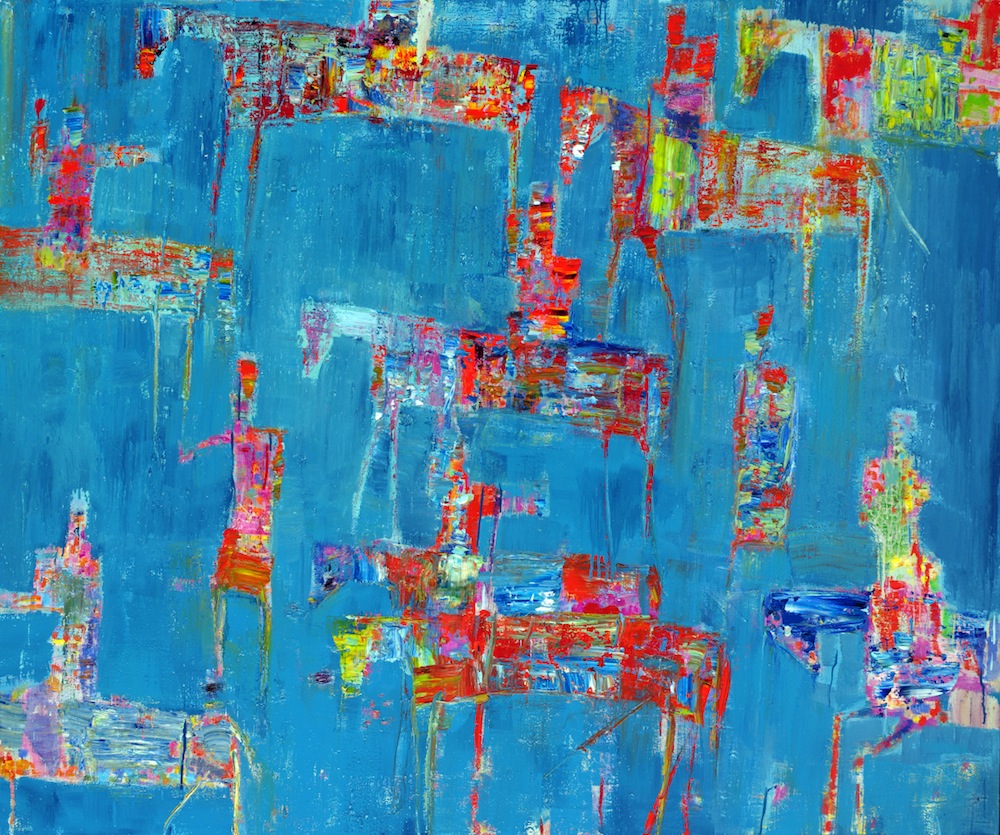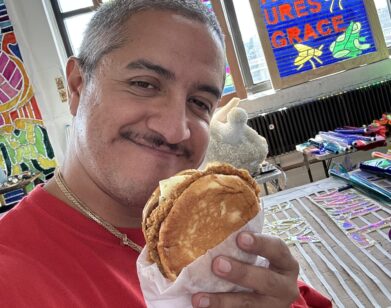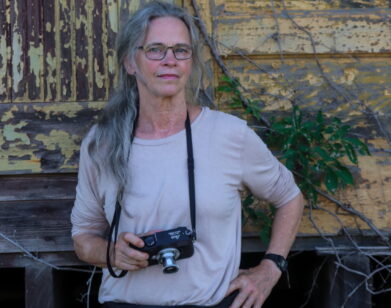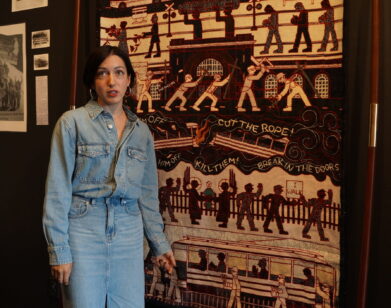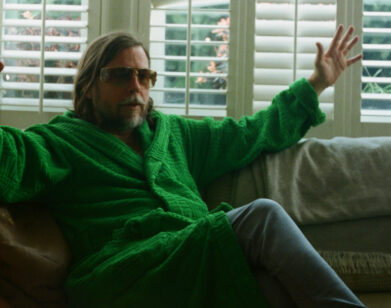Reza Derakshani, Far From Home
On the heels of a solo show at London’s newly inaugurated Sophia Contemporary Gallery, artist Reza Derakshani celebrated the opening of his first exhibition in Russia last week at The State Russian Museum in St. Petersburg. The survey of his work includes the brightly colored figurative paintings for which he is widely recognized as well as his more recent, minimal canvases. Born in a small Iranian village in 1952, Derakshani grew up on a mountain in a small black tent, before nomadically traveling and living around the country. He occasionally saw art in books, although his interest in creating both art and music was only solidified when he attended university.
“Up until art school in the ’70s, I had never seen an original masterpiece,” he recalls. “The Tehran Contemporary Art Museum opened and that was the first time I saw works of de Kooning, Pollock, and Bacon.”
The influences of these Abstract Expressionists and figurative artists can clearly be seen in Derakshani’s work, though he adapts the styles to reflect Middle Eastern culture. In one series, Derakshani presents pomegranates, their seeds becoming geometric dotted patterns connected by thin lines, almost taking the form of a chemical compound’s visual representation. (In ancient Persia, the fruit symbolized fertility; there is still an annual Pomegranate Festival held in Tehran.) In other series, he focuses on subject matter like the King and Queen, Persian miniatures, and fig trees.
Following graduation from the University of Tehran, Derakshani left for Paris and California, where he studied at the Pasadena School of Art. He returned briefly to Iran but fled in 1983 after the Islamic Revolution, soon finding himself in New York for more than 15 years, and then Italy. Derakshani eventually returned once again to his homeland in the early 2000s—only to find a country and culture to which he couldn’t relate. Subsequently, he left the country again in 2009, and hasn’t looked back since. Now, he is based between Dubai and Austin, Texas.
Derakshani’s lifelong nomadic nature is reflected not only in his evolving subject matter and style of painting, but also in his poetry and music. Lines of his writings often find their way into his paintings, as do those of Rumi and other Sufi poets, while he also performs and releases music, including two critically acclaimed albums in collaboration with John Densmore of The Doors.
Two days after the opening of his exhibition at The State Russian Museum, we met Derakshani to discuss his artistic roots and practices over coffee.
EMILY MCDERMOTT: In the last year, you moved toward abstraction in place of figuration, but then back to the figure with the female singers. How did that shift occur?
REZA DERAKSHANI: When I went to New York for a couple of years, I did a lot of abstract work but I realized I wasn’t going to be a purely abstract artist. There was something missing. From that point on things changed and my visual lens grew. I’m always at the edge; there’s always the influence of abstract art, even if I do very figurative art. Talking about painting, I think the more you know about different styles and ways of working, the richer the work gets. I don’t like to be categorized in a certain way—as a Middle Eastern artist, as a painter, as an only abstract artist, or only figurative artist. It’s a big world. You don’t want to define yourself too narrowly and get stuck. Art is about liberties. It’s about the mind and senses flowing and discovering. It’s a universe by itself. I cannot imagine being forced to just do one thing, as the market dictates. That’s probably one reason I’m not good in galleries. They mostly want you to stick to your “thing” because of the market.
MCDERMOTT: And you also have your music.
DERAKSHANI: Yes, and last year I started doing large-scale, outdoor sculpture—very abstract with metal, welding, glass, plastic, and some unusual material. I always want to experiment, and sculpture is something you need space and materials to do. I had never created the kind of environment for that, but then I went to Austin and felt like, “Okay, I can do it now.” I built a sculpture studio with cranes, all kinds of welding materials, metal.
MCDERMOTT: What brought you to Austin? I’m curious how you became based between Texas and Dubai.
DERAKSHANI: It’s not intentional. I never thought I was going to live in Dubai. In 2009, when I was in Iran, things got a little bit awkward and at one point I decided to leave immediately, kind of run away. Dubai was close so I thought, “Go there, start life, start working.” That was a matter of convenience. After a couple of years, I thought I should have a base in the States. I was thinking about New York, so I went in the middle of winter and it was cold and sick. Then I went to Austin to visit a friend and there were beautiful sunny skies and it was warm. I found it interesting and relaxing, and people are nice. I found this amazing property as if it was built for me, so I said, “Why not? Let’s try and see if it works or not.” If not, I’ll change again. I’m used to that. I’ve been brought up that way.
This environment and the circumstances [in Austin] make me feel good. I created a music studio, a sculpture studio, and painting studio, so what else does an artist need to create? In general, anytime I’ve moved from one place to another, some new or different things come into my work. In Austin, it’s been sculpture and the very huge scale of working. Dubai was an extension of what I was doing in Tehran, but with a bit more of the decorative edge. If you live somewhere new, something from outside your mind should be accepted and you should see whether it works or not. Trying to fight that is not necessarily a good thing.
MCDERMOTT: Going back to 2009, can you talk about what happened that made you want to immediately leave Tehran?
DERAKSHANI: There was the Arab Spring in Tehran a couple of years before that, which was a lot more magnified. It was a rise of fundamentalists and affected you one way or another, especially for someone who lived a couple of decades outside of that society. There were times where I felt like I didn’t belong to the country anymore: I couldn’t connect to the people around me; I could not understand them; they could not understand me. It was a different world. There were small groups, mostly the younger generation, and I had more connection with them. But people of my own generation I couldn’t connect with. They said things and there were all kinds of feelings—animosity, jealousy. Publically it was said, “Watch him, he’s with the mafia.”
The first couple of years I was there, it was quite fun. It wasn’t that intense. It was during the more moderate period. There was hope, there was a feeling of looking up—same as what’s happening now. But all of a sudden things changed after the elections. There were hardliners in power and you could see it everywhere. You could feel it in the air. One of my interviews with a daily newspapers was about what I did in Italy, where I painted a private chapel at Sting’s residence. Some people couldn’t take it: “If you can do that kind of thing in Italy, you should’ve been connected to the mafia because it’s not easy to get into that!” It was a strange time and then it gradually became worse and worse and worse. I personally got some bad vibes and some poking, so I thought, “I can’t work anymore. I can’t concentrate.” I decided to leave and I haven’t been back.
MCDERMOTT: So with artists and the general public questioning you, how did you deal with that?
DERAKSHANI: You have to ignore it. That’s the only way. If you get into it, it gets ugly. On the other hand, the system, I realized, still has problems with people who have certain amounts of success but don’t belong. They try to poke you or do something that will make you want to leave the country or surrender. For example, my younger brother is a famous musician in Iran. His passport was revoked because he recorded with female musicians. He was coming to visit me in Dubai last year and all of a sudden they took his passport.
MCDERMOTT: Is that in part what inspired your recent female singer series?
DERAKSHANI: No, that was before. Those paintings are about women of a different period, before the revolution. But because of what happened, they either had to flee the country or be in exile. They all lost their lives, their status as a performer. Some had tragic endings. That inspiration is always with me. Philosophically, there is a strong force against any kind of beautiful, joyful thing that [improves] life, and I couldn’t take that.
MCDERMOTT: A lot of your work deals with exile, like these women as well as the queen and king series. Do you ever feel like you, yourself, are exiled?
DERAKSHANI: I would say I have the same situation. I left in the early ’80s and couldn’t go back for 20 years, and it’s pretty much the same thing [now]. Back then, it was much more obvious that I couldn’t go back, but this time around it’s uncertainty. I don’t know what would happen. Maybe nothing would happen, but if I lost my passport, I’d be paralyzed. That’s one reason why I don’t even think about going back. That uncertainty is not a good feeling.
MCDERMOTT: Going back to your childhood, I know you were raised in the wilderness on a mountain and didn’t really experience art until you were at college. But what about music, what role did music have in your life growing up?
DERAKSHANI: I used to sing when I was a kid. It was natural. I had a voice and a passion for music. I remember as a little kid doing outdoor, public theater during religious festivals. They were all musicals with no talking. In one story there were two kids of one Imam—I used to play one of those kids. The point was to sing in a way that would make people cry, and I could do that. My family was a big family and a lot of times the women would call on me and would sit around and I would sing for them and they would cry. [laughs]
I always wanted to learn instruments but never had the chance until I got to college. It was a hobby for me, but as everything else I do, like painting, I took it very seriously. I practiced two hours everyday in the morning. I never thought I was going to do it professionally, but when I left Iran, I was in Rome and a club asked me to do a concert. It was my first public performance. When I moved to California, I got invited to do a concert in New York. That was the beginning of my professionally creating music. It just went on and on and I did collaborations with Western musicians of different genres.
MCDERMOTT: Yeah, I know you recorded two albums with John Densmore, the drummer from The Doors.
DERAKSHANI: Yeah, that’s one of them. For a few years in New York, actually, I did more music than painting. It was more convenient because it was just me and my instrument. Now the focus is on art, but the music is coming back.
MCDERMOTT: How do you see each practice influencing the other?
DERAKSHANI: They do in many ways. Emotions are slightly different, the way of expression, but there are elements in each form that can influence the other. Looking back at Persian visual arts could have been an influence of the music that I was doing, which was totally Persian, very emotional. I would make myself cry. Gradually, the music changed and found a new form, and painting looked back to the traditions, so they met halfway. It was more peaceful. Before that, I could feel the conflict between the two.
MCDERMOTT: I want to talk about the phrase “These roots drink quietly,” which you’ve used to name a few of your paintings. I know it’s a line from a Rumi poem, but what does it mean to you?
DERAKSHANI: That’s an amazing piece that I’ve read since I was young. Somehow it forced itself into my work. I always loved nature; I used to draw trees quite a bit when I was a kid and then I did my pomegranate series and fig trees. Those are more abstract, but have roots in nature. The pomegranate series immediately made a connection to Rumi’s piece. It’s a very joyful yet philosophical way of looking at the universe. I have quite a bit here and there in my pomegranate series. [recites a verse of Rumi’s poem in Persian] It’s a big piece, but this verse is saying what happened to these trees? What are they going to be? Will there be fruits or not? It says forget about that; just look at the change of the universe, this circulation of seasons, and then you will be okay, you will find out what’s going to happen. Language by itself is very artful. Rumi’s language is so simple but so deep that even most Persians don’t understand what it’s about.
MCDERMOTT: The simplest things are often the most complex.
DERAKSHANI: Yeah, and that’s really an amazing form of art, playing with words. Persian language is made for this, that’s why the biggest form of art in the Persian culture and history is poetry.
“REZA DERAKSHANI” WILL BE ON VIEW AT THE STATE RUSSIAN MUSEUM UNTIL JULY 25, 2016. FOR MORE INFORMATION ON THE ARTIST, VISIT SOPHIA CONTEMPORARY GALLERY’S WEBSITE.

